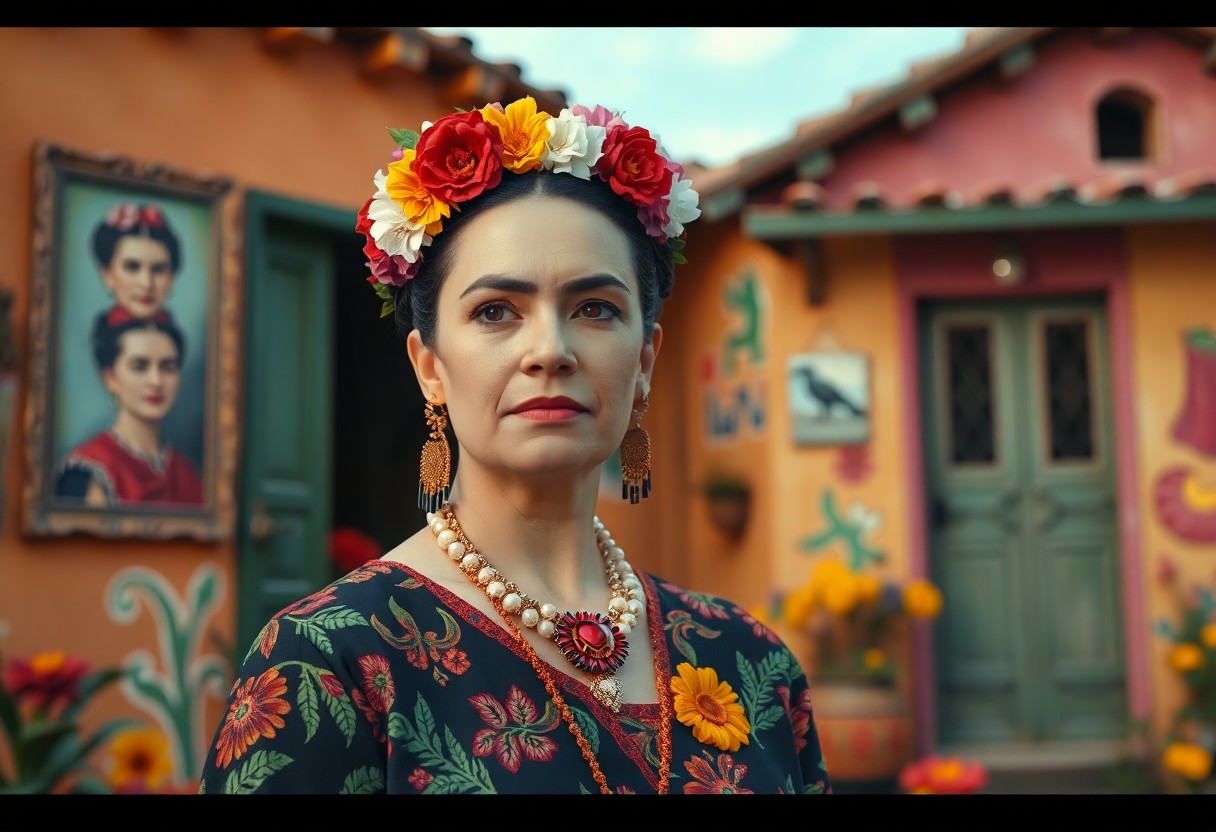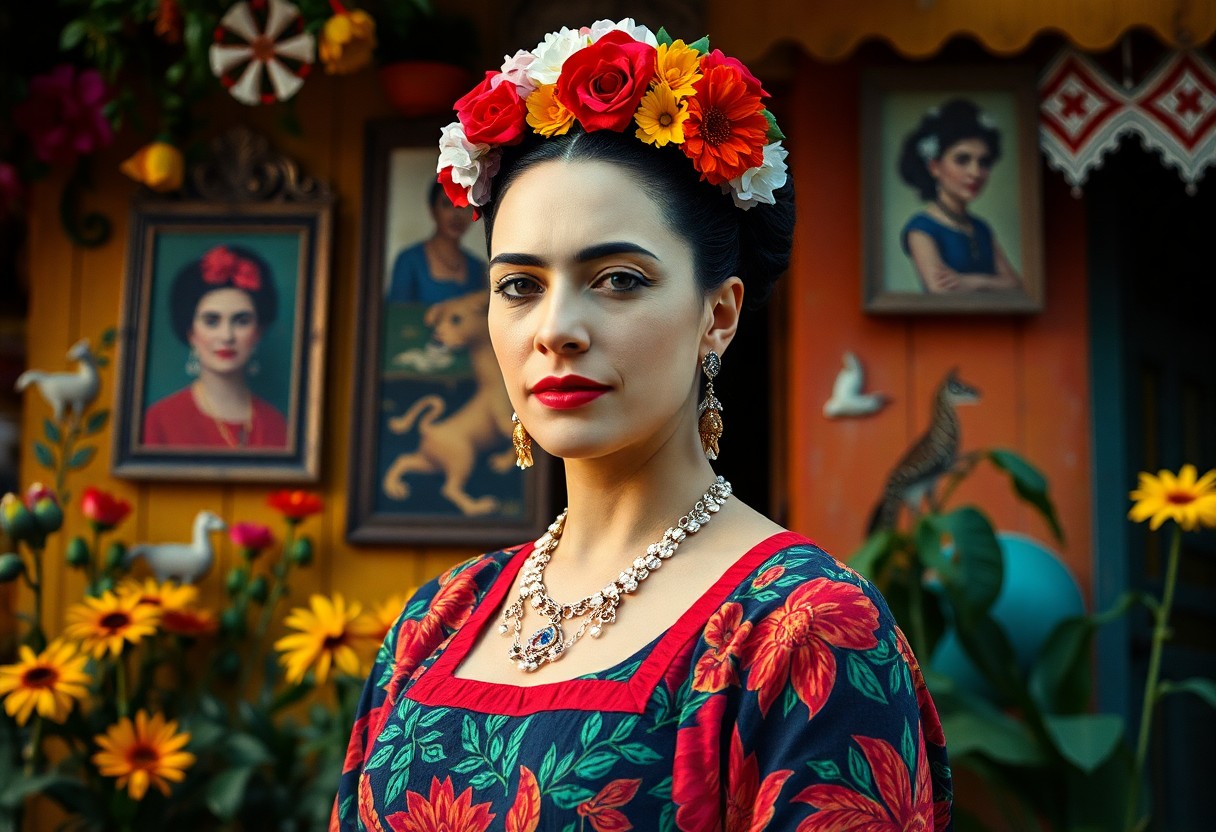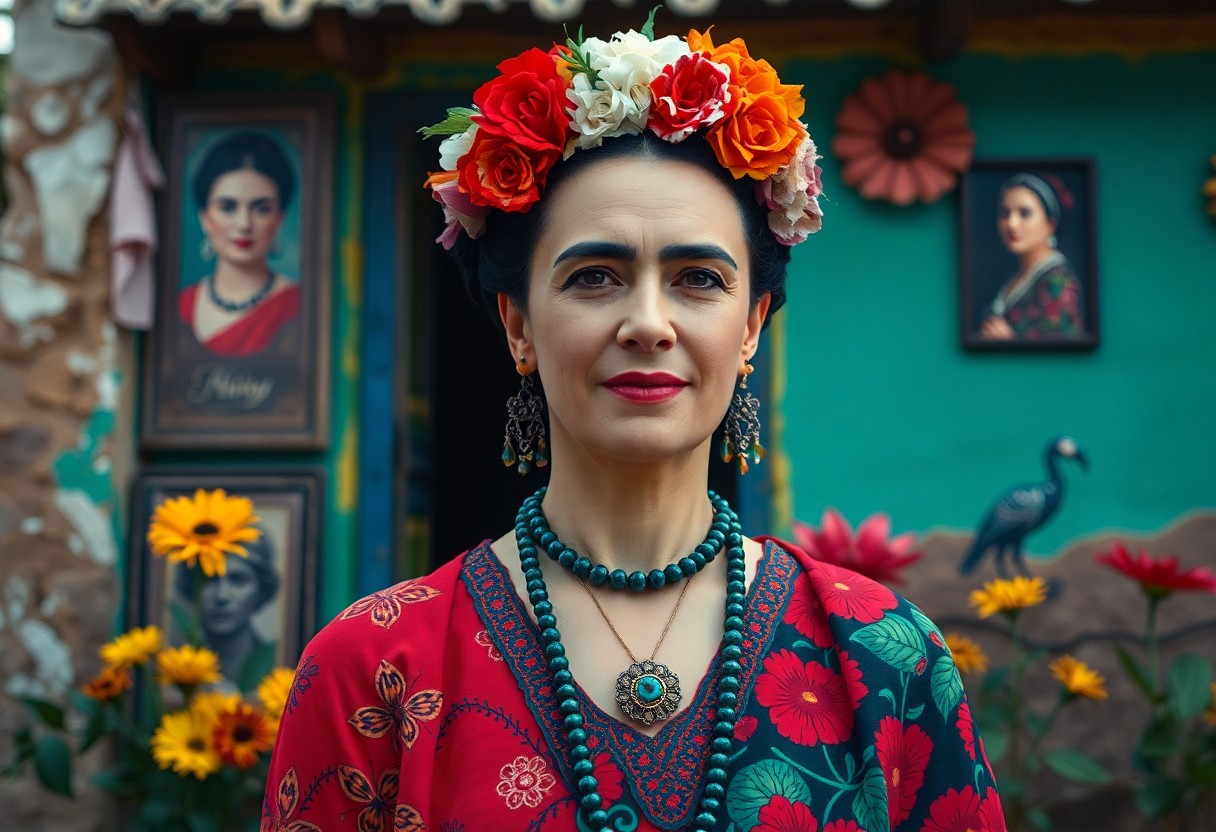It’s through her profound suffering that you discover the remarkable journey of Frida Kahlo, an artist who transformed personal trauma into powerful visual narratives. Facing physical pain and emotional turmoil throughout her life, Kahlo found strength in her creativity, and her distinctive style painted a vivid portrait of her struggles. By embracing her identity and experiences, you’ll see how she emerged as a feminist icon, challenging societal norms and inspiring countless individuals to express their own hardships through art.
Key Takeaways:
- Frida Kahlo’s art deeply reflects her personal experiences with physical pain and emotional turmoil, which she transformed into powerful visual narratives.
- Her distinctive style, characterized by vibrant colors and symbolic imagery, allowed her to explore themes of identity, postcolonialism, gender, and class.
- Kahlo’s struggles with health issues, including polio and a severe bus accident, significantly influenced her creative expression and led her to embrace her vulnerabilities.
- By openly addressing her own suffering, Kahlo became a voice for women facing similar challenges, challenging traditional views of femininity and beauty.
- Her unapologetic exploration of topics such as sexuality, miscarriage, and mental health positioned her as an early feminist icon in the art world.
- Kahlo’s rebellious spirit and defiance against social norms have continued to inspire contemporary feminist movements and artists today.
- Through her legacy, Frida Kahlo encourages individuals to confront their pain and transform it into a source of strength and creativity.

Early Life and Struggles
Your journey into the life of Frida Kahlo begins with her early years, shaped by a blend of cultural richness and personal adversity. Growing up in Mexico City during the early 20th century, Frida was influenced by her family’s Mexican heritage and the tumult of the Mexican Revolution. These factors ignited her passion for identity, art, and self-expression, laying the groundwork for her later creations that would resonate deeply with universal themes of pain and resilience.
Childhood Influences
For Frida, childhood was a canvas painted with vivid experiences that would profoundly impact her artistic journey. The influence of her father, a photographer of German descent, and her mother, a devout Catholic, instilled in her a diverse cultural perspective. These elements shaped her worldview and inspired her to confront societal norms in her art, particularly regarding femininity and identity.
Health Challenges
Beside her cultural upbringing, health challenges marked Frida’s early life, forging her unique perspective on suffering and resilience. An early bout with polio left her with physical limitations, but it was a tragic bus accident at age 18 that would change her life forever.
Plus, this accident resulted in numerous injuries, including a broken spinal column, pelvis fractures, and leg injuries, leading to multiple surgeries and a lifetime of chronic pain. This harrowing experience fueled Frida’s artistic expression, as she transformed her anguish into profound visual narratives. Her canvases became a powerful testament to her struggles, where she explored themes of identity, suffering, and femininity, ultimately establishing her voice as an icon of resilience and feminism.

Artistic Journey
Some of Frida Kahlo’s most profound art emerged from her personal experiences. From a young age, she faced numerous challenges including a debilitating accident that left her in pain for much of her life. These struggles deeply influenced her artistic journey, allowing you to witness her evolution from self-portraits to explorations of identity, pain, and the human spirit. Her works reflect not only her suffering but also her passionate response to the political and cultural landscape of her time.
Style and Techniques
Behind her vibrant use of color and surreal imagery, Frida Kahlo developed a unique style that blended elements of Mexican folk art with personal symbolism. You’ll find that her techniques often included symbolic self-portraiture, showcasing emotional depth and interconnectedness with her surroundings. This allowed you to enter her world, filled with personal narratives and cultural symbols.
Key Works and Themes
To fully grasp Frida Kahlo’s significance, you should explore her key works and the themes embedded within them. Her pieces, such as “The Two Fridas” and “The Broken Column,” encapsulate her struggles with identity, love, and physical pain. Each painting serves as an intimate diary of her life experiences, inviting you to reflect on your own perceptions of pain, resilience, and femininity.
Further, the themes of identity, struggle, and empowerment resonate in Frida’s artworks, offering you a perspective on how personal experiences can lead to artistic expression. Her portrayal of physical and emotional pain emphasizes her strength, while also making a broader statement about the female experience. Understanding her key works helps you appreciate her enduring impact as not just an artist, but a cultural icon who challenged societal norms and explored the essence of being a woman in her time.
Feminism and Identity
Keep in mind that Frida Kahlo’s exploration of her identity transcended traditional gender norms. By openly expressing her physical and emotional pain, she challenged societal expectations and redefined what it meant to be a woman. You can see her art as a profound reflection of her complex identity, where she embraces her individuality and confronts both personal and collective struggles, making her a timeless symbol for feminism.
Exploration of Gender Roles
Any examination of Kahlo’s life reveals her defiance against conventional gender roles. She unabashedly presented her desires, sexuality, and vulnerabilities, pushing against the limitations enforced by patriarchal society. Her art serves as a powerful commentary on the complexities of womanhood, encouraging you to embrace your own identity beyond societal expectations.
Impact on Feminist Movements
For many, Kahlo became a symbol of strength and resilience within feminist movements. Her raw imagery and unfiltered perspective resonate with women facing oppression, inspiring a sense of empowerment.
In addition to influencing your understanding of feminism, Kahlo’s legacy has a profound impact on contemporary feminist movements. Her unapologetic celebration of her body and experiences encourages you to challenge the norms and stereotypes surrounding femininity. The rawness of her art highlights important themes like self-acceptance and individuality, offering a voice to those who feel marginalized. Ultimately, Kahlo’s work is a rallying call that invites you to find strength in vulnerability and asserts that your story is significant and worthy of expression.
Cultural Legacy
Once again, Frida Kahlo’s indelible mark on the art world extends beyond her lifetime, enriching cultural dialogues around identity, pain, and feminism. You can see her influence reflected in contemporary art movements, where personal narratives and raw emotions are celebrated. Kahlo’s work challenges traditional gender roles and encourages you to explore your own narrative as a form of empowerment. Her ability to connect deeply with viewers makes you feel seen and understood, solidifying her role as a transformative cultural figure.
Influence on Future Artists
Influence permeates generations of artists inspired by Kahlo’s passion and vulnerability. You can find her signature style echoing in the works of those who explore gender, race, and heritage in deeply personal ways. As her emotive storytelling paves the path for authenticity in art, aspiring creators like you are compelled to embrace your pain and triumphs. Frida encourages you to turn your experiences into powerful visual expressions, ensuring her voice continues resonating.
Global Recognition
After her passing, Frida Kahlo’s work gained astonishing global recognition, evolving from a niche interest into a phenomenon celebrated worldwide. You can witness her influence in blockbuster exhibitions and extensive retrospectives, highlighting her body of work’s profound emotional depth. This newfound visibility has ignited a resurgence of interest in both her art and her role as a feminist icon, extending her legacy far beyond her home country of Mexico.
Consequently, her art became a symbol of resilience and self-acceptance, appealing to audiences of varied backgrounds. This movement positioned her not just as a local figure but a global icon, proving that your struggles can resonate with others across cultures. Art collectors and enthusiasts alike are now increasingly valuing her work, while academic discourse thrives, exploring themes like identity, gender politics, and postcolonialism. As you examine into her legacy, you become part of a larger conversation, amplifying her influence in contemporary culture.

Personal Life and Relationships
To truly understand Frida Kahlo’s art, you must probe into the tumultuous landscape of her personal life and relationships. Her experiences with love, pain, and identity significantly shaped her creations, allowing you to see how the complexity of her emotional world translated into her powerful imagery. Each relationship added layers to her story, making it necessary to explore the dynamics that influenced her artistic expression.
Marriage to Diego Rivera
Against the backdrop of a volatile love story, Frida’s marriage to renowned muralist Diego Rivera became a profound influence on her life and art. Their passionate yet tumultuous relationship was marked by infidelity and artistic collaboration, ultimately serving as a source of both inspiration and anguish. You can see echoes of their connection in her works, where themes of betrayal and emotional intensity often take center stage.
Impact of Personal Relationships on Art
Against the odds of emotional turmoil, Frida Kahlo’s personal relationships were a driving force behind her artistic expression. Her love life, especially her bond with Rivera, influenced her themes of pain, loss, and identity. These intimate experiences became a springboard for her creativity, allowing you to witness how her relationships informed her iconic style and subject matter.
Plus, you can find that Frida’s relationships not only fueled her emotional struggles but also birthed some of her most famous works. The intensity of her experiences with love and heartache taught her to channel pain into visual storytelling. She often painted self-portraits that reflected her vulnerability, capturing the impacts of her relationships and revealing raw emotions. You’ll notice that these themes persist in her art, making her work resonate with anyone who has experienced a complex love or identity struggle.
Pain as Inspiration
After enduring a lifetime filled with physical and emotional anguish, Frida Kahlo transformed her suffering into profound art. Each brushstroke of her work captures the essence of her pain, allowing you to connect with her experience on a deeply emotional level. Her ability to channel turmoil into creativity solidified her as a pioneering artist, demonstrating that pain can be a powerful catalyst for expression and a source of identity.
Transforming Suffering into Creativity
Before Frida became a celebrated artist, she faced relentless challenges, from childhood polio to a horrific bus accident that left her with lifelong injuries. These trials shaped her perspective, leading her to weave her experiences into vibrant, symbolic narratives. Through this transformation, she encourages you to view personal suffering as a potential source of artistic revelation.
The Role of Pain in Her Artistic Expression
To comprehend the significance of pain in Frida Kahlo’s artwork, you must recognize how it served as both a muse and a theme. Kahlo’s ability to depict her struggles with raw intensity allows you to explore the intersection of pain and beauty. Her self-portraits often showcase her physical suffering, including her chronic ailments and emotional turmoil, compelling you to confront uncomfortable truths while celebrating resilience and strength.
Understanding the role of pain in her artistic expression reveals the depth of Frida Kahlo’s work. Rather than shy away from her physical and mental challenges, she embraced them, creating a unique visual language that speaks to your inner turmoil. By portraying themes of identity, loss, and self-discovery, she illustrates that art can be a sanctuary for processing pain. Kahlo’s journey reminds you that acknowledging your struggles can produce profound creative expressions, ultimately transforming anguish into empowerment.
Conclusion
With this in mind, you can appreciate how Frida Kahlo transformed her personal suffering into a powerful form of artistic expression. By channeling her pain into her work, you can see how she touched on themes of identity, gender, and resilience, ultimately becoming a feminist icon. Your understanding of her impact deepens when you recognize how her life story encourages self-exploration and empowerment, inviting you to embrace your own experiences and utilize them as a canvas for your voice and creativity.
FAQ
Q: How did Frida Kahlo’s personal pain influence her art?
A: Frida Kahlo faced significant physical and emotional pain throughout her life, stemming from polio in her childhood and a severe bus accident in her teenage years. These experiences deeply influenced her artwork, which often reflected her suffering. Kahlo used symbolism and vivid imagery to express her feelings of pain, identity, and resilience, transforming her struggles into powerful visual storytelling. Her art serves as a cathartic outlet, allowing her to confront and process her trauma, making pain a central theme in much of her work.
Q: In what ways did Frida Kahlo challenge traditional gender roles?
A: Frida Kahlo defied traditional gender roles through her expression of femininity and her exploration of sexuality, body image, and identity. She openly embraced her identity as a woman while challenging societal expectations. Kahlo often depicted herself in a way that celebrated her unique beauty and individuality, as seen in her self-portraits. Her boldness in addressing topics such as female experience, reproductive health, and gender identity has made her a feminist icon, inspiring countless women to embrace their own stories and challenges.
Q: Why did Frida Kahlo become a feminist icon?
A: Frida Kahlo became a feminist icon because her life and work exemplify themes of female empowerment and self-expression. She challenged the norms of her time by exploring complex aspects of womanhood, including suffering, loss, and sexuality. Kahlo’s unapologetic authenticity and refusal to conform to societal standards resonated with many women. Furthermore, her political activism, particularly regarding issues like women’s rights and indigenous culture in Mexico, solidified her status as a symbol of feminism and empowerment.
Q: How did Frida Kahlo use symbolism in her artwork?
A: Symbolism plays a vital role in Frida Kahlo’s artwork. She frequently incorporated elements such as animals, plants, and traditional Mexican motifs to convey deeper meanings associated with her experiences. For example, the monkey often represents her need for companionship, while the deer in “The Wounded Deer” symbolizes her vulnerability. Kahlo’s use of symbolism enables viewers to engage with her work on multiple levels, allowing for personal interpretations of her pain, identity, and resilience.
Q: What impact did Frida Kahlo have on modern art and culture?
A: Frida Kahlo has had a profound impact on modern art and culture, influencing a wide array of artists and movements. Her distinctive style and emotional depth have inspired contemporary feminists and activists advocating for women’s rights. Kahlo’s work invites discussions around identity, trauma, and the female experience, resonating with new generations. Additionally, her life story—filled with resilience and authenticity—continues to inspire countless individuals striving to express their truth in various forms of art and activism.
Q: How did Kahlo address issues of identity in her artwork?
A: Kahlo explored themes of identity in interconnected ways, particularly regarding her Mexican heritage and personal experiences. Throughout her art, she incorporated symbols and patterns associated with her culture, expressing pride in her roots. Her mixed-race background also played a role in her exploration of identity, as she depicted her struggles as a woman who navigated both Western and indigenous Mexican cultures. By using her art to confront these issues, Kahlo invited discussions about identity, heritage, and belonging.
Q: What is the significance of self-portraits in Frida Kahlo’s work?
A: Self-portraits hold significant importance in Frida Kahlo’s body of work, as they allow her to express her innermost thoughts and feelings. By consistently depicting herself, Kahlo invites viewers into her personal narrative, creating a sense of intimacy and vulnerability. Her self-portraits often reflect her physical pain, emotional struggles, and her quest for identity. These representations bridge the gap between the artist and the audience, establishing a profound connection through shared experiences of suffering, resilience, and self-acceptance.
